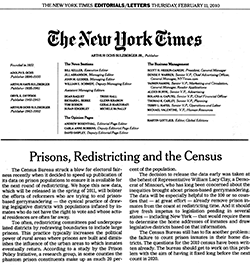If tax-paying part-time residents shouldn’t be counted outside their home districts, neither should incarcerated people
Editorial: if part-time residents can’t be counted at their second homes, consistency requires incarcerated people to be counted at home, not at the prison.
by Aleks Kajstura, February 19, 2010
In a recent editorial, “In new Census, home is where the vote should be,” the Times Herald-Record (Orange County, NY), examines the issue of prison-based gerrymandering in the larger context of voting and election law in New York State.
If it is not right to let a two-month bungalow colony resident vote in the Town of Bethel or the owner of a year-round vacation home vote in Taghkanic, then it should be even less acceptable to let thousands of people who cannot vote, who do not pay taxes, and who really would rather be somewhere else count toward the population of an Assembly, Senate or House district.
I don’t share the paper’s pessimism that we need litigation to resolve where incarcerated people should be counted, I think we can resolve this problem on the core principle of our democratic process: one person, one vote. Fairness, accuracy and the New York State Constitution demand that incarcerated people not be counted as constituents of politicians far from their home districts.
Note: The New York State Const. Article 2, Section 4 provides that “no person shall be deemed to have gained or lost a residence, by reason of his presence or absence … while confined in any public prison.”
 Prisons, Redistricting and the Census
Prisons, Redistricting and the Census


